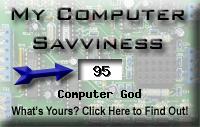Macs and Speed
Lately, there have been a rash of "switcher" articles, where an advanced Windows and/or Linux user takes the Macintosh package for a spin. There's one from OSNews, one from ExtremeTech and several from AnandTech.
In many of these articles, the author will mention the lack of responsiveness in the UI or choppiness in some of the UI animations (like Exposé). This is particularly the case with power users who are used to top-shelf PCs. Unless you're running a Dual 2.5GHz PowerMac G5 with a couple Gigs of RAM, a Radeon 9800 XT, and Apple's 20" Cinema Display (nothing larger), you probably won't be able to perceive the true power you have at your finger tips just by the feel of the user interface. I wish it wasn't true, but it is. All I can do is attempt to explain why.
Apple's core markets are publishing and video: graphics. Except for crunching massive amounts of scientific data, there is nothing more demanding you could ask a computer to do. In addition, to compete in these markets Apple needed products that would offer the highest quality graphics environment available from anyone. Which brings us to Quartz.
Quartz is MacOS X's graphics subsystem and it's the highest quality graphics subsystem available on any operating system. While most OS's have 2D graphics systems based around bitmaps, Quartz is based on PDF. Add this to the fact that Apple's external monitors have high native resolutions, (to the point that Apple's 30" monitor requires this dual head video card just to use it) and you have a recipe for SLOW. Apple's Quartz Extreme enhancements just show that Quartz is really a graphics system designed for the hardware of 2010 rather than today's equipment.
In the long run this will be good for Apple, but today it's hard to make the case for Apple's machines being fast when they often feel slow.




0 Comments:
Post a Comment
<< Home